1886 (null)
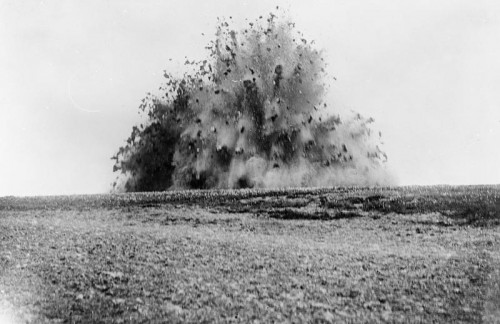
The explosion of a mine at the Mining School at Aubigny, 12th May 1916 / © IWM (Q 572)
View case studyThe Nobel Dynamite Trust
The Nobel Dynamite Trust is created as a 'multinational' of German and British companies, selling 'superior blasting powder' all over the world.
The Naval Defence Act is passed to increase the power of the Royal Navy. This sparks similar German laws and a rapid increase in naval spending on the continent.
1889 (null)
Vickers buys the Barrow Shipbuilding Company and its subsiduary Maxim-Nordenfelt.
1897 (null)
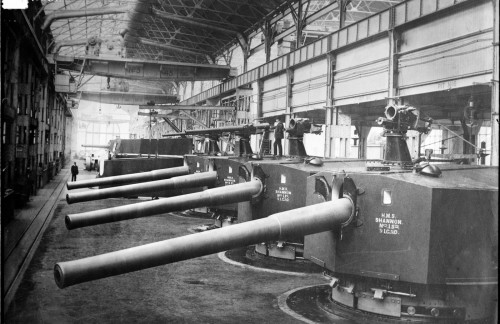
Vickers buys Barrow image / Via Wikimedia Commons. http://tinyurl.com/pmwz6ml
View case studyThe Laird Brothers of Birkenhead complete work on the Domingo Faustino Sarmiento; a ship commissioned by the Argentinian Navy for the purposes of training their troops.
1897 (null)
The international peace conference that results in the first Hague Convention opens.
1899 (May)
The Second Boer War begins.
1899 (October)
The Exportation of Arms Act is given Royal Assent, giving the head of state the power to prevent arms being sold when they could be used against British troops.
1900 (August)
William Beardmore & Company start work on the naval construction yard at Dalmuir in the west of Clydebank. It would become the largest and most advanced shipyard in Britain during the opening years of the twentieth century.
1900 (null)
Harvey United Steel Company, Limited established - described by the Union of Democratic control as 'the first combination to illustrate the international character of the armament business'.
1901 (null)
The Second Boer War ends. The British won the war but the Boers were promised limited self-government.
1902 (May)
Arthur Balfour becomes Prime Minister and continues the Conservative reign of Britain.
1902 (July)
1902 (October)

The tune we dance to / © reserved; Collection Religious Society of Friends in Britain, 2014
View case studyVickers & Krupp
A debacle over royalty payments to German firm Krupp for shell fuzes begins.
1905 (null)

Leaflet from the Liberal Publication Department expressing support for the National Insurance Act /
View case studyBlowing brains out or putting them in?
Military spending is debated as a new Finance Bill is put before Parliament.
The Coventry Ordnance Works was formed by a merger of several British shipbuilding firms. This was encouraged by the government in the hope of increasing competition in the arms industry.
1905 (null)

A female worker cleans the rifling of a 15-inch gun after being lifted inside the barrel in the Coventry Ordnance Works during the First World War / © IWM (Q 30135)
View case studyAs Edward VII visits Sheffield, the city’s role in defence is celebrated.
1905 (null)
1905 (null)

Film poster for Major Barbara, 1941 / Source unknown
View case studyMajor Barbara produced
George Bernard Shaw's play, 'Major Barbara', about the nefarious arms dealer Andrew Undershaft is produced for the first time.
Henry Campbell-Bannerman forms a minority government led by the Liberal Party after Arthur Balfour resigns as Prime Minister. The Liberals would win a landslide in the election on the platform of 'peace, retrenchment and reform'.
1905 (December)
1906 (May)
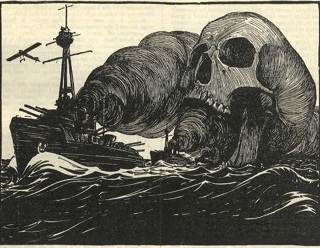
The Naval Menace Cartoon / © Peace Pledge Union Archives
View case studyMulliner & the big navy scare
Mr. Mulliner of Coventry Ordnance Works starts lying to the Admiralty about vast naval expansion in Germany in the vain hope of increasing his orders.
The RMS Lusitania launches, briefly the world's biggest ship. She was constructed at the shipbuilders of John Brown & Company in Scotland and would be sunk in 1915 by German U-boats, an incident that would contribute to the United States entering the war.
1906 (null)
An international peace conference resulting in the second Hague Convention is held. Although it did not make much more progress than the first conference in 1899, it laid the groundwork for future international conferences.
1907 (June)
The HMS Inflexible launches. Built on the Clyde by John Brown & Company, this order would be followed by the battlecruisers HMAS Australia and HMS Tiger, as well as the battleship HMS Barham. A naval arms race had begun.
1907 (June)
British state spending on arms drops to its lowest since the beginning of the twentieth century.
1907 (null)
Henry Campbell-Bannerman resigns as Prime Minister due to ill health and the Chancellor Herbert Henry Asquith takes over as Prime Minister, staying in post until 1916.
1908 (April)
The International Socialist Congress is held in Stuttgart and concluded that socialists should do everything they could to stop the outbreak of war.
1907 (August)
Naval estimates are published, showing an increase of £2,823,200 on the preceeding year. In July Parliament will vote to build four new dreadnoughts.
1909 (March)

Mr. Mulliner with the Kaiser and Uncle Sam in a cartoon from 'Puck' magazine, 1908 / © Creative Commons
View case studyThe big navy scare hits no.10
Mulliner's Big Navy Scare reaches Number 10 Downing Street. 10 days later the government plans to increase naval spending.
Admiral Count H. Togo, Chief of the Japanese Naval General Staff, visits Hadfields Ltd. in Sheffield.
1911 (null)
At the Annual Conference of the Scottish TUC the following resolution is carried: 'this Congress strongly condemns any action likely to lead to war between nations, and pledges itself to every endeavour for peace, by co-operating and fraternising with Continental workers to make war impossible.'
1913 (null)
1913 (null)
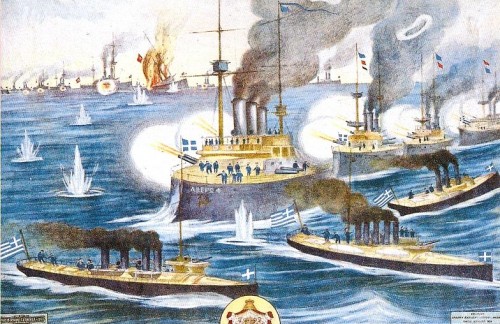
Greek and Ottoman fleets clash in the Naval Battle of Lemnos, January 1913 / © Creative Commons
View case studyOttoman navy scandal
Leading British arms firms sign a lucrative contract to refurbish the Ottoman naval dockyards and arsenals; these weapons are later used against Allied troops in the Dardenelles.
Mr Swift MacNeill introduced a 'Ten Minute Rule' Bill to ‘disable members from holding directorships in armament companies,’ after an unnamed MP and director of Cammell Laird received a contract to build a Dreadnought shortly after he gave a speech in the House on the subject.
1913 (null)
Oskar Peterrson, a freelance journalist living in Hamburg visits Leicester on his European tour, stirring up local politicians to denounce the arms trade. He explains that the German middle classes are furious with German manufacturer Krupp, after it bribed a right wing French newspaper to publish anti-German articles.
1914 (January)
Siemens had a monopoly over Japanese naval contracts, and, via their Japanese agents, Mitsui, offer a bribe of 15 percent to secure contracts. Vickers tries to outmanoeuvre Siemens by offering a kickback of 25 percent in exchange for the contract for the battlecruiser Kongo.
1914 (January)
Archduke Franz Ferdinand of Austria, heir to the Austro-Hungarian throne, and his wife, Sophie, Duchess of Hohenberg, shot dead in Sarajevo.
1914 (June)
Germany invades Belgium. Britain declares war on Germany.
1914 (August)
Ramsay McDonald resigns as leader of the Labour Party in protest at the war and is replaced by the pro-war Arthur Henderson.
1914 (August)
Defence of the Realm Act is passed giving the government wide ranging powers to requisition supplies needed for the war and to make new criminal offences.
1914 (August)
1914 (August)

James Maxton / © National Portrait Gallery. Creative Commons Licence. http://tinyurl.com/mcjoroz
View case studyGlasgow against the War
Large anti-war demonstration in Glasgow; the speakers make direct links between struggles for workers' rights and limiting the profits of the arms traders.
1914 (September)
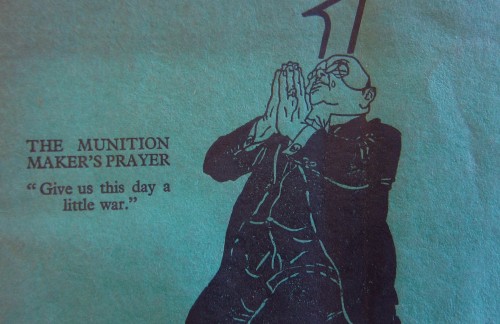
The Munition Maker's Prayer, 1932 / Courtesy of Trades Union Congress Library
View case studyUDC established
The Union of Democratic Control established to lobby for more democratic foreign policy and a reduction of armaments after the war.
The Trading with the Enemy Act is given Royal Assent, making it a crime to do business with 'the enemy'.
1914 (September)
1914 (November)
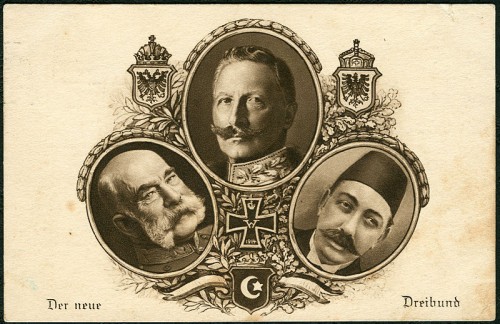
Kaiser Wilhelm II, Mehmed V, Franz Joseph: the three emperors of the Central Powers / © Creative Commons
View case studyWar declared on Ottoman Empire
Britain and her Allies declare war on the Ottoman Empire, which had been armed by leading British firms in the preceding years.
1914 (November)
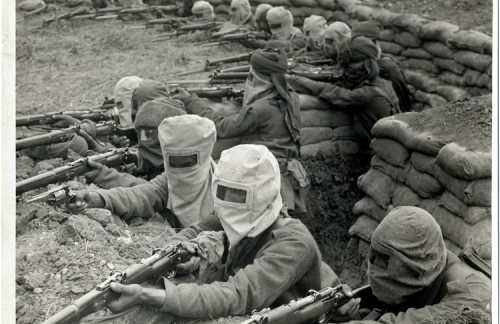
Indian infantry in the trenches, prepared against a gas attack in Fauquissart, France. / © British Library
View case studyChemical weapon testing starts
Chemical Substance Committee of the Royal Society War Committee established to experiment with chemical weapons before they are first used in the war.
10,000 engineering workers in Glasgow take unofficial strike action for an increase in wages. This led to the founding of the Clyde Workers' Committee which would resist the Munitions Act.
1915 (February)
The Treasury Agreement, a settlement between the trade unions and the government, is signed. It formalises the arrangement that strike action would be suspended for the duration of the war, and permits 'dilution'; the recruitment of non-skilled or female labour into skilled positions.
1915 (March)
The 'shells scandal' appears in the headlines of The Times and The Daily Mail as the press baron Lord Northcliffe blames Field Marshal Kitchener for the army's shortage of supplies.
1915 (March)
The Allies launch the Gallipoli campaign after failing to open the Dardanelles strait. Turkish troops successfully trap the Allies on the beaches of Gallipoli; the campaign is a failure for the Allied forces.
1915 (April)
The first Women's Peace Congress at the Hague: delegates from 12 countries protest the war.
1915 (April)

Caricature of 1915 International Women's Congress at the Hague, / © Women's International League for Peace and Freedom, Swarthmore College Peace Collection
View case studyFirst Women's Peace Congress
'Peacettes' from 12 countries brave hazardous travelling conditions to protest the war at the Hague.
Asquith is forced to create a short-lived Coalition Government with the Conservatives, partly due to the political fallout from the disaster of Gallipoli and the 'shell crisis'.
1915 (May)
1915 (May)
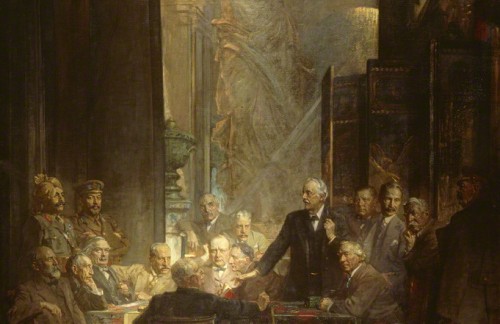
Statesmen of World War I by Sir James Guthrie / © National Portrait Gallery. Creative Commons Licence. http://tinyurl.com/39k5wm
View case studyA businessman's organization?
The Ministry of Munitions is created in response to the shell crisis.
Miners strike in South Wales due to understaffing, over work and rising food prices. They feel that their patriotism is being exploited and that the Conservative press is casting them as villains when they consider that the mine owners are to blame. A negotiated wage agreement brings an end to the strike.
1915 (July)
The Munitions of War Act is passed by Parliament. This makes strikes and restricting output a criminal offence. The act was not effective, Britain was the country with the most industrial disputes during the war bar Russia.
1915 (July)
1915 (August)
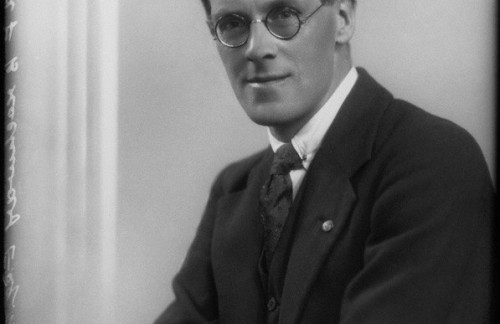
Fenner Brockway / © National Portrait Gallery. Creative Commons Licence. http://tinyurl.com/39k5wm
View case studyLabour Leader raided
The Labour Leader office in Manchester is raided under the Defence of the Realm Act. Copies of The Devil's Business, Fenner Brockway's play about the arms trade are confiscated and the author arrested for publishing seditious material.
Landlords raise rents as the demand for housing increases, leading to a rent strike organised by women. Terrified by this increasing radicalisation, the Government pass the Rent Restriction Act in response.
1915 (October)

Women from Glasgow organised to resist threats of evictions from landlords and began a campaign of non-payment of rents which forced the government to pass legislation preventing any war-time increases in rents / courtesy of Glasgow Caledonian University Special Collections and Archives, Gallacher Memorial Library
View case studyThe Finance Act introduces an Excess Profits Duty applicable to all trades and businesses that were not under the control of the Ministry of Munitions and where their profits exceeded their pre-war standard profits by £200 or more.
1915 (December)

The Steel Converter at Woolwich Arsenal. By William Hyde / © IWM (Art.IWM ART 2275)
View case studyRestricting profits?
Gilbertson's steel company is declared a controlled establishment by the government. The owner writes to complain, in his view this unfairly threatens their profits.
By the end of the year 5000 women are employed in the National Projectile Factory at Templeborough
1915 (December)
The Military Service Act is granted royal assent and brings conscription into effect.
1916 (January)
1916 (February)
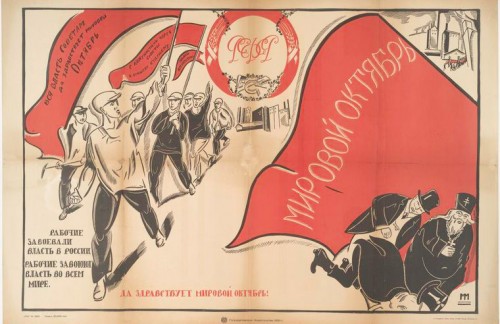
Long live world october / © Creative Commons
View case studyJohn Maclean arrested
John Maclean is arrested for the second time for speaking out against the war. The 6th charge describes a joke made by Maclean about munitions workers pawning German made alarm clocks and sleeping in.
Six leaders of the Clyde Workers' Committtee are arrested and deported for organising strikes against profiteering and for higher wages. The next day James Maxton and others call for strike action at a great protest demonstration at Glasgow Green.
1916 (March)
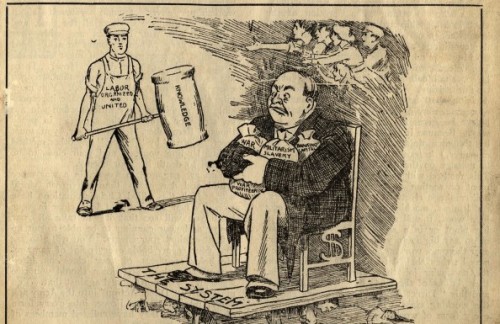
Cover of 'The Red Dawn', the official organ of The Proletarian Schools and College, a syndicalist inspired magazine for young workers / courtesy of Glasgow Caledonian University Special Collections and Archives, Gallacher Memorial Library
View case studyStrikers arrested
James Maxton is arrested for inciting munitions workers to down tools in protest against the deportation of Clyde Workers' Committee members.
1916 (June)
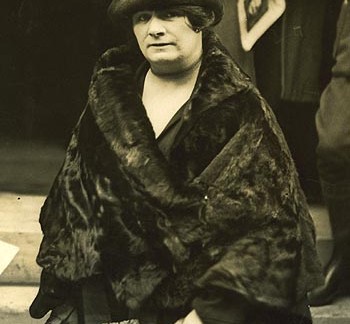
Helen Crawfurd / Courtesy of Gallacher Memorial Library, Glasgow Caledonian University Special Collections and Archives
View case studyWomen's peace crusade launched
'Dangerous women' launch the Glasgow Women's Peace Crusade. In June 1917 the Women's Peace Crusade launches nationally.
1916 (June)
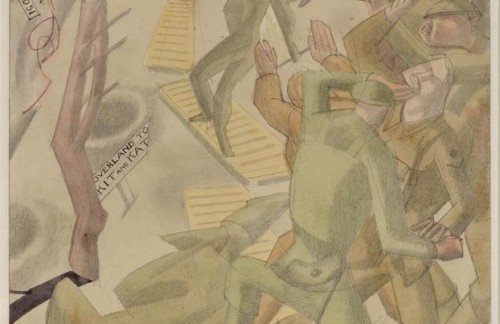
Drawing by William Roberts of a group of British soldiers caught in an explosion as they make their way along a duckboard / © IWM (Art.IWM ART 1170)
View case studyNobel Dynamite Trust closes
Nobel Dynamite Trust finally winds up after 22 months of British shareholders profiting directly from British deaths.
The Battle of the Somme begins. More than one million men would be wounded or killed over the course of this battle. It ended on 18 November 1916.
1916 (July)
1916 (September)

'For King and Country': the interior of a munitions factory with female workers making shells, 1918 / © IWM (Art.IWM ART 6513)
View case studyShells, shells and more shells!
Munitions workers at Quedgeley finally get a rest after spring and summer bank holidays were suspended to keep production high.
David Lloyd George becomes Prime Minister of a Coalition Government. Asquith goes into opposition with the majority of the other Liberals, Lloyd George controls a Government mostly made up of Conservative ministers.
1916 (December)
1917 (January)
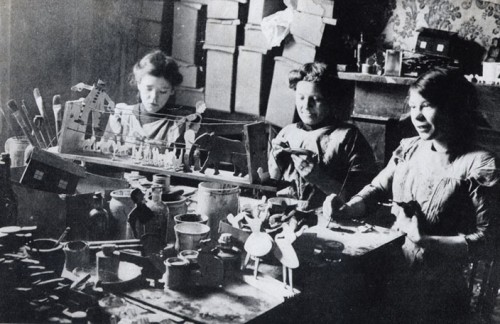
Sylvia Pankhurst's toy factory: home-based work in a domestic environment in Bow, c. 1915 / © Tower Hamlets Local History Library
View case studySylvia Pankhurst threatened with libel
Sylvia Pankhurst publishes facts about profiteering and poor working conditions in arms firms in 'The Women's Dreadnought,' and is threatened with libel action.
The Russian Czar is forced to abdicate and the next day a largely centre-left provisional government is formed.
1917 (March)
Congress votes for war after the sinking of seven US merchant ships by Germany. The United States enters the First World War on the side of the Allies.
1917 (April)
The Bolsheviks take power in Russia.
1917 (October)
1917 (November)
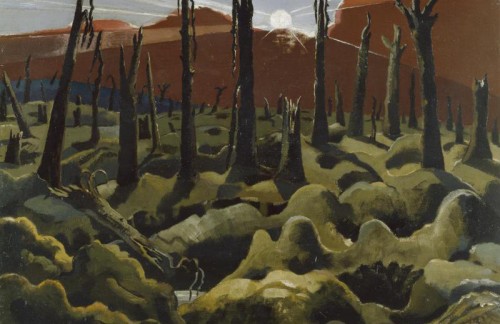
We Are Making a New World by Paul Nash, 1918 / © IWM (Art.IWM ART 1146)
View case studyPaul Nash
In a letter home from the Ypres Salient war artist Paul Nash writes: 'I am no longer an artist interested and curious, I am a messenger who will bring back word from men who are fighting to those who want the war to go forever'.
28,000 women are working at the Woolwich Arsenal, just under half of the workforce.
1917 (null)
The Manpower Bill, dubbed the Manslaughter Bill by James Maxton, extends conscription to older men and some previously protected groups of workers and, controversially, to Ireland.
1918 (January)
1918 (February)

One of the Imperial War Museum's art galleries at Crystal Palace / © IWM (Q 17028)
View case studyJohn Singer Sargent
The new British War Memorials Committee plan to build a Hall of Remembrance, for the central piece of art they commission the artist John Singer Sargent.
On May Day there is a mass strike and anti-war demonstration in George Square, Glasgow, one of the biggest ever, with an attendance of around 100,000.
1918 (May)
At five am the Allies sign an armistice with Germany, leading to a ceasefire and the end of the First World War at eleven that same morning.
1918 (November)
The Women's International League for Peace and Freedom poll Birmingham election candidates on their disarmament views. 10 out of 15 respondents were in favour of free, non-militaristic education and the establishment of a League of Peoples, with provision for universal disarmament.
1918 (November)
A national election, won by the Conservatives, although the Liberal, Lloyd George remained as Prime Minister. This was the first election in which women could vote.
1918 (December)
John Brown & Company, the shipbuilders who created more destroyers than any other during the War, estimate that during the conflict it produced a total of 205,430 tons of ships.
1918 (null)
1918 (null)
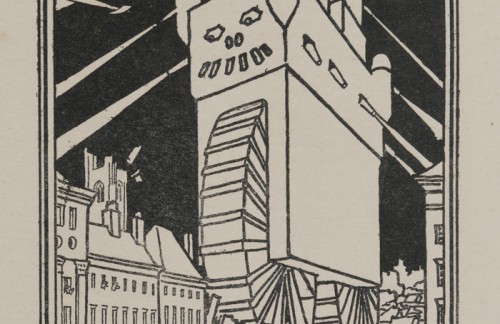
'The Obliterator,' a nightmarish vision of a weapon of mass destruction by Quaker artist Joseph Southall / © Reproduced with permission of the Barrow Family/Photo © Birmingham Museums Trust
View case studyE.D Morel's imprisonment condemned
Artist Joseph Southall condemns E.D. Morel’s imprisonment in the satirical fable 'The Earth and the Moon,' in which politicians contrive imaginary threats to escalate war.
An intense year of industrial unrest as Lloyd George fails to create 'a land fit for heroes.' 35 million working days are lost due to strikes - six times as many as the previous year. The Russian Revolution may have galvanised workers' spirits and offered an example for some.
1919 (null)
Elections are held for the National Committee for the Hands off Russia! Movement - a campaign founded by British Socialists to organise opposition to the British intervention against the Bolsheviks in the Russian Civil War.
1919 (January)
1919 (May)

WILPF British delegation to Second International Congress of Women in Zurich, 1919 / © Women's International League for Peace and Freedom/ © Library of the London School of Economics and Political Science, LSE/WILPF/22/1
View case studyThe second International Congress of Women is held in Zurich and aims to influence the Paris Peace Conference, which they condemn as 'imperialist and full of weakness.'
The Treaty of Versailles is signed, ending the state of war between Germany and the Allied Powers.
1919 (June)
1919 (November)
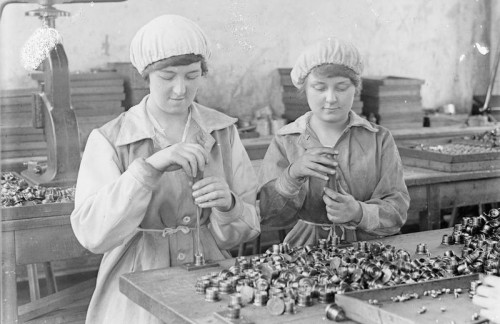
Female workers in the Quick Firing Cartridge Factory at the Royal Arsenal, Woolwich, May 1918 / © IWM (Q 27890)
View case studyPromises for Woolwich Arsenal
Lloyd George visits Woolwich Arsenal and promises to look into alternative work while workers campaign for a 'Peace Arsenal' in order to save their jobs.
1919 (December)
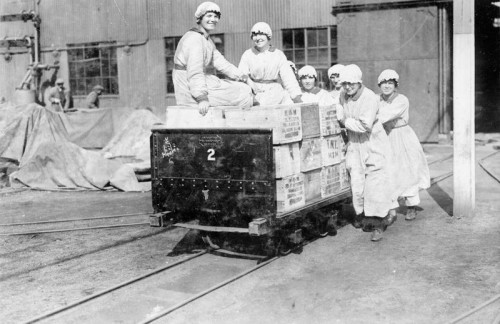
Female munitions workers are pushed along on a trolley loaded with cases of explosive material by their colleagues out to the railway siding of their factory during the First World War / © IWM (Q 54658)
View case studyGive us jobs!
Local people ask for alternative work to be provided at the Queensferry explosives factory where six thousand people had been employed during the war.
The League of Nations holds its first council meeting in Paris, six days after the Treaty of Versailles came into force.
1920 (January)
1920 (May)
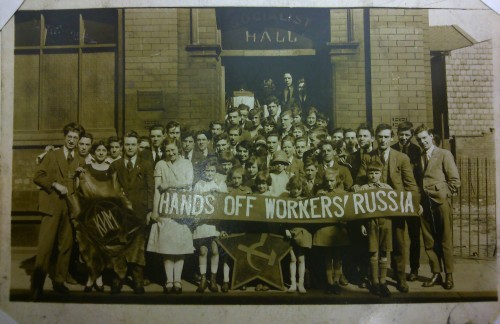
Young Comrades League outside Margaret Street Socialist Hall, 1927 / © Working Class Movement Library, Salford
View case studyA war was stopped
London Dockers refuse to load coal on the SS Jolly George, a ship loaded with arms bound for Poland to be used against the Bolsheviks.
The Trade Union Conference expresses opposition to the arms industry.
1920 (September)
1921 (null)
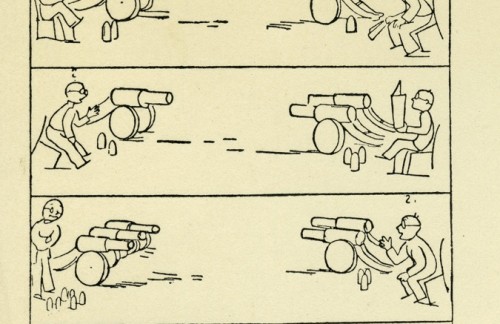
Armaments do not give security! / © reserved; Collection Religious Society of Friends in Britain, 2014
View case studyWhat a waste
The Limitation of Armaments is published by Major-General Maurice. After the First World War even ex-military staff argued for disarmament.
The Workers Union congress resolves: 'We believe that there is no expenditure so wasteful and so harmful as the expenditure on armaments… Let us realise that the greatest monument that we can erect to our dead comrades is our determination to see that the sacrifices they made shall not have been made in vain.'
1921 (null)
The number of workers at the state-owned Woolwich Arsenal drops to 6,500. Over 50,000 jobs were cut from its wartime peak.
1922 (null)
The Washington Naval Treaty is signed with the intention of stopping an arms race. It places limits on the naval powers with a strong focus on agreements between Britain, America and Japan.
1922 (February)
After several scandals the Conservatives break from the Lloyd George-led coalition and form a Government under Andrew Bonar Law.
1922 (October)
Stanley Baldwin becomes the next Conservative Prime Minister after Bonar Law resigns due to ill health.
1923 (May)
Japanese Admiral Ito is sentenced to prison for accepting bribes (in connection with the building of a battle cruiser for the Japanese Navy), from representatives of Vickers, Yarrow, and Weir.
1923 (null)
Ramsay MacDonald becomes the first Labour Prime Minister, but his government does not last the year due to a concerted campaign by right wing newspapers and Stanly Baldwin takes office once again in November.
1924 (October)
The League of Nations fails to find enough countries to ratify a draft Convention on the Arms Trade. Britain refuses to sign it.
1925 (null)
In an effort to stop the wage reductions of 800,000 coal miners, The Trades Union Congress calls a General Strike. One and a half million people take part.
1926 (May)
1926 (May)

North Wales Peacemakers' Pilgrimage / © Archives and Special Collections, Bangor University
View case studyWomen on the march!
2,000 women marchers arrive at Camarthonshire to take part in the Peacemakers' Pilgrimage.
Many companies in the chemical industry that make incendiary explosives and gas bombs combine to form the Imperial Chemical Industries.
1926 (December)
1927 (March)
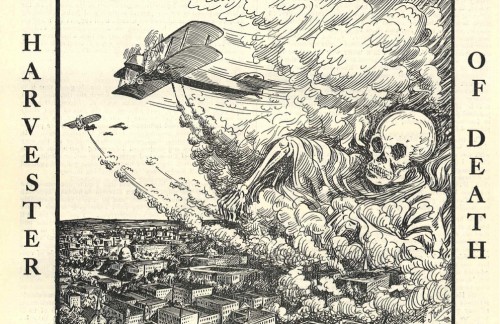
Harvester of Death Cartoon / © Peace Pledge Union Archive
View case studyAbolish the air force
In the House of Commons, MP Arthur Ponsonby moves a resolution to abolish the air force. He argues that Britain should lead the world with a direct proposal to disarm.
Despite its parent company Hadfields Ltd. investing almost $3 million, the American based Hadfield-Penfield goes into receivership as the arms industry struggles in the relatively peaceful twenties.
1927 (October)
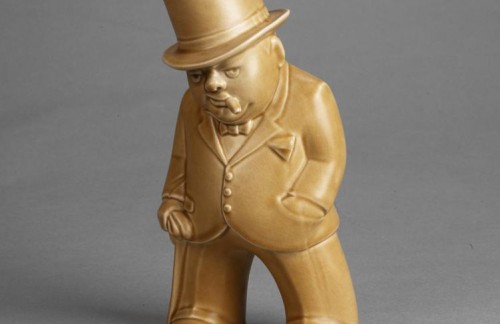
Bovey pottery figure of Winston Churchill titled 'The Boss'. / © IWM (EPH 4180)
View case studyTax payers pick up the bill
Winston Churchill pushes through a fusion scheme in which the Bank of England effectively bails out arms firms Vickers & Armstrong.
The League of Nations sets up a commission to draft a Convention for the Supervision of the Private Manufacture and Publicity of the Manufacture of Arms and Ammunition and Implements of War. However, member states are reluctant to share information on the arms licenses they had granted.
1928 (null)
1928 (July)

The General Council of the Women's Peace Crusade, 1929 / © Archives and Special Collections, Bangor University
View case studyThe Kellogg Pact
The Women's Peace Crusade's successful campaign to promote the Kellogg Pact, a proposal by the American government to renounce war, culminates in a mass meeting at Queen's Hall, London. 200 Welsh Women attend.
Ramsay MacDonald wins the general election and forms a Labour Government. However, the pressures of balancing budgets during a recession means that by 1931 a coalition government with the Conservatives is created.
1929 (May)
'Goodbye to All That' by Robert Graves is published, shortly followed by 'All Quiet on the Western Front' by Erich Maria Remarque. Critical interpretations of the First War World become more common and widespread.
1929 (null)
1930 (October)
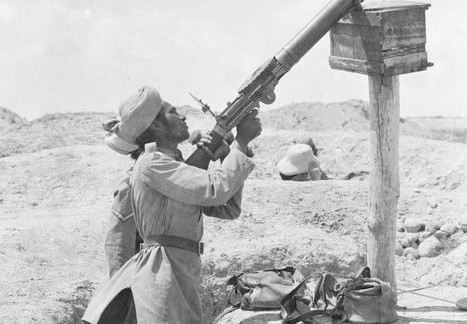
Indian Sepoy using Lewis gun as Archie, 1917 / © IWM (Q 24676)
View case studyPeddling surplus guns
Birmingham Small Arms Company subcontracts its right to broker sales of surplus First World War guns almost anywhere in the world to Captain John Ball.
Over the next 14 months Great Britain ships to China: 9,720,000 machine guns and revolver cartridges, 74 machine guns, supplies of aircraft bombs, thousands of pounds worth of rifles, aeroplane mountings and parts. To Japan - 8,954,000 machine gun cartridges, 860 machine guns, and aircraft bombing mounts.
1931 (August)
Japan invades Manchuria. The conflict is one of the first major tests of the League of Nations.
1931 (September)
The Trades Union Congress steps up its disarmament campaign: 'Labour fights wars and then pays for them. Disarm!'
1931 (null)
At the World Disarmament Conference (1932 – 1934) in Geneva the differences between the Conservatives, who favour rearmament, and Labour / the Liberals who favour disarmament are split open.
1932 (null)
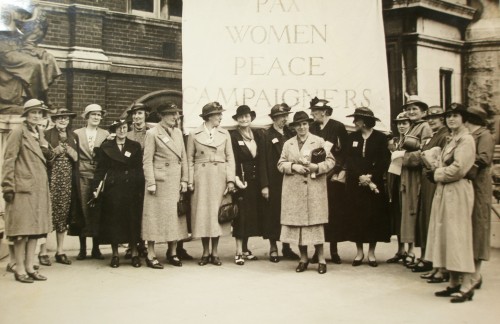
Women's International League for Peace and Freedom members in London, 1932 / © Women's International League for Peace and Freedom (UK)
View case studyWomen take on the world
Olga Miser reports the contemptuous treatment of the Women's International League by male delegates at the World Disarmament Conference.
1932 (July)

Unless civilization can break with armaments, armaments will break civilization, from 'No More War', July 1924 / © Peace Pledge Union Archive
View case study'Peace book' created
No More War Movement devises the 'Peace Book' - emergency measures for pacifists to counter war preparations, and to rival the government's 'War Book.'
The Chaco War intensifies between Bolivia and Paraguay. This is the first large scale aerial war in the Americas. Examples of armaments rings formed by companies such as ICI and Vickers selling to different sides of the conflict increased popular interest in the arms trade in Britain.
1932 (September)
Adolf Hitler is appointed German Chancellor.
1933 (January)
The Oxford Union votes to support the motion: this house shall not fight for King and country! This creates a press furore, and the students are accused of making Britain look weak on the international stage.
1933 (February)
The first session of the 'Nye Committee' or the Special Committee on Investigation of the Munitions industry is held in the United States. Its eventual report would increase pressure for a British version of the committee by exposing scandals concerning British armament firms.
1934 (September)
1935 (February)

Ramsay MacDonald at the Tomb of the Unknown Soldier in 1929 / Library of Congress
View case studyThe arms trade is put on trial
Ramsay MacDonald announces the Royal Commission into the Private Manufacture of and Trade in Arms.
According to media that reported at this time, the British government supplied practically all the foreign exchange used by the Nazi government to buy raw materials for its arms industry and the director of the Bank of England secretly negotiated loans to Hitler.
1935 (May)
1935 (June)

Peace Ballot /
View case studyThe Peace Ballot
The results of the Peace Ballot are announced at the Albert Hall. Over 90% vote for disarmament in Britain's first (unofficial) referendum.
The first major rearmament programme since the war is introduced to improve the air force.
1935 (July)
Fascism is becoming an increasingly aggressive threat as Italy attacks Abyssinia.
1935 (October)
Hitler re-militarises the Rhineland. In London, the Royal Commission on the Private Manufature of and Trading in Arms is delayed, while the government issues a defence White Paper to implement rearmament plans.
1936 (March)
1936 (June)
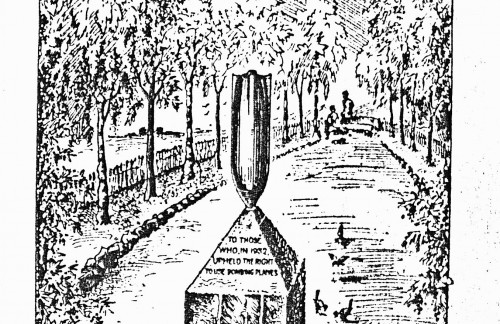
Unveiling of the first anti-aerial warfare protest monument, 21st June 1936 / Copyright unknown
View case studyStone bomb memorial
Anti-aerial warfare protest monument commissioned by Sylvia Pankhurst is unveiled for the second time (it was demolished by fascists the first time).
Stanley Baldwin becomes Prime Minister for the third time as Ramsay MacDonald's health worsens. In the subsequent general election Baldwin promises 'I give you my word that there will be no great armaments'.
1936 (June)
The Spanish Civil War begins. This is the first conflict to see the use of large scale aerial bombing.
1936 (July)
Princess Frederick Leopold of Prussia writes an appeal to peace campaigner Elizabeth Cadbury: 'But now when the world seems to have gone mad and all those that manufacture weapons to kill and cripple men.... shall we women really quietly look on and not join in all countries to fight against such a terrible affliction as another war would be?'
1936 (October)
1937 (May)
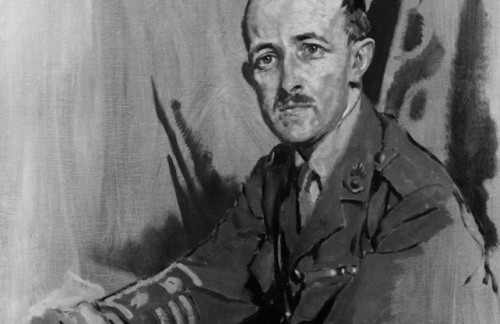
Maurice Pascal Hankey, by Sir William Orpen / © National Portrait Gallery. Creative Commons Licence. http://tinyurl.com/39k5wm
View case studyThe government interferes
After a long delay a White Paper based on Maurice Hankey's report is published, which ignores all the recommendations of the Royal Commission for greater control of the private trade in arms. The government continues to rearm using private firms.
